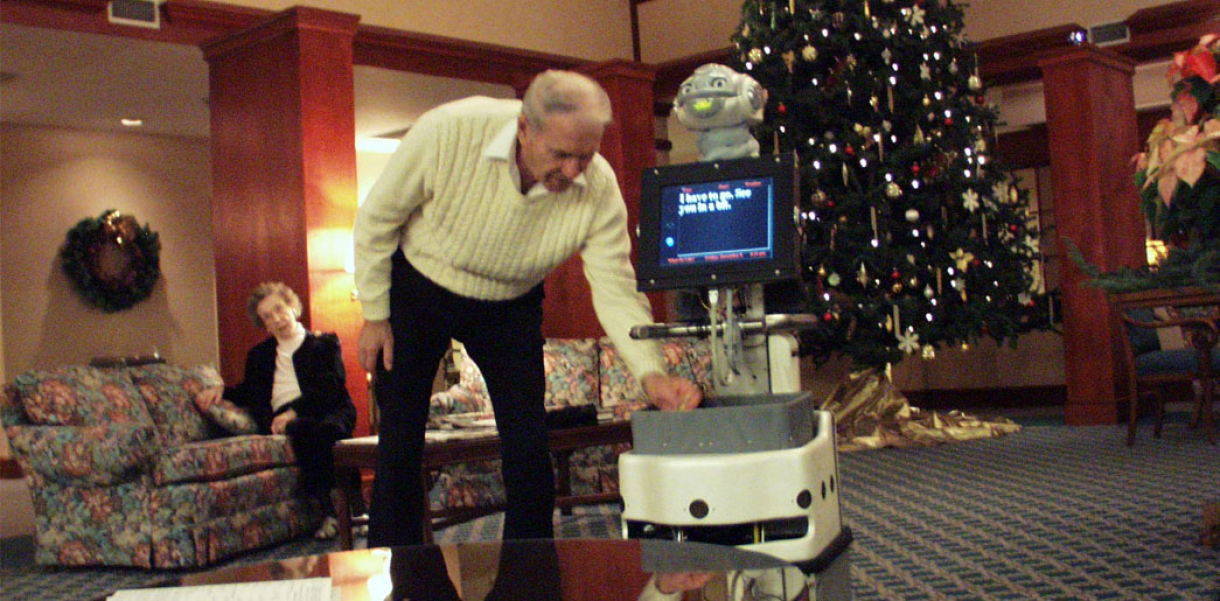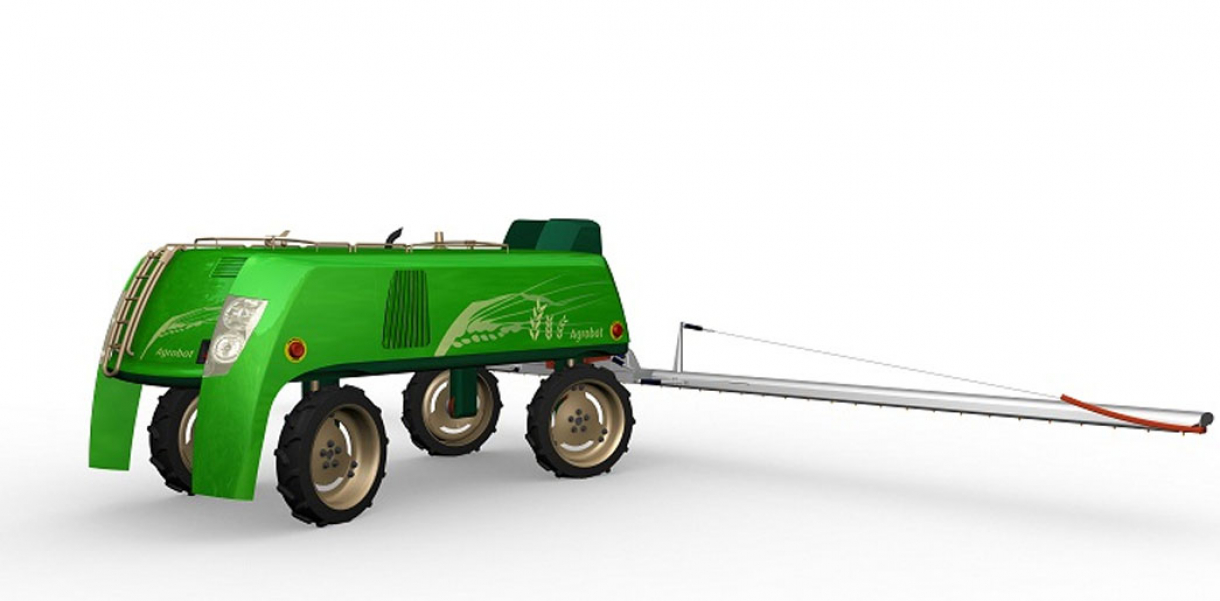Pearl the Nursebot is a prototype of the PERSONAL ROBOTIC ASSISTANTS FOR THE ELDERLY, an inter-disciplinary multi-university research initiative focused on robotic technology for the elderly designed to help the elderly live independently rather than being forced into nursing homes. This personal mobile robotic assistant can help the elderly with daily tasks, provide companionship and even help them to remotely communicate with physicians and caregivers
Functionality and use of design
The NurseBot combines leading-edge research in robotics, artificial intelligence, interaction design, health care, and social science and psychology to deliver functions such as Intelligent Reminding, Tele-presence, Data-collection and Surveillance, Mobile Manipulation, and Social Interaction.
How did this design improve life?
Developed by an interdisciplinary team of researchers and designers at Carnegie Mellon University’s People and Robots Laboratory, the University of Pittsburgh School of Nursing, Stanford University, the University of Michigan and the Art Institute of Pittsburgh, Pearl the Nursebot is designed to help the elderly live independently rather than being forced into nursing homes. This personal mobile robotic assistant can help the elderly with daily tasks, provide companionship and even help them to remotely communicate with physicians and caregivers. As one researcher said, “We have succeeded in helping people to live longer. Now we need to help them live better.”
NurseBot is one example of a large field off worldwide research into “Assistive Technologies” for the elderly and the handicapped. But beyond those specialized populations it has been demonstrated that hat designing for so-called disabled people often yields products that are better for the population at large. The title for this approach to design is “Universal Design”, For example, sidewalk curb-cuts for wheelchair users turn out to benefit delivery people, skate-boarders, and people with canes, crutches, baby carriages, shopping carts and wheelie luggage. Or OXO kitchen tools, originally designed for elderly people with arthritis, has transformed the kitchen tool industry.
The goal of the NurseBot project is to develop mobile, personal service robots that assist elderly people suffering from chronic disorders in their everyday life. “Pearl”, the NurseBot is an autonomous mobile robot that "lives" in a private home of a chronically ill elderly person. The robot provides a research platform to test out a range of ideas for assisting elderly people, such as: What would you like to have a robot help out with around the house?
For the rising tide of elderly people, having a reliable assistant who can help with daily tasks and provide a level of companionship could be the difference between being able to live independently and being forced into a nursing home. It would also change the way health care is delivered, so these seniors could remain in their homes and enjoy a better quality of life for as long as possible. These are the stakes for robots like Pearl the NurseBot.
Researchers are exploring important issues about what functions a robot assistant could provide to senior citizens—as well as learning more about the way people interact with a robot when they introduce more “human-like” characteristics. Pearl is a prototype personal mobile robotic assistant that can recognize speech, follow patients around and communicate via a touch screen. She is being groomed to remind seniors to take their medication, see the doctor and keep from getting lost. She could also serve as a “telepresence” for remote checkups with caregivers.
But, Pearl’s ultimate success will depend on whether people just plain like being around her. To that end, a multidisciplinary team of roboticists, social scientists and interaction designers has drawn on theories of emotion from cognitive science and the principles of aesthetics to explore what happens when human characteristics are added—or taken away—from Pearl’s “persona.”
“We certainly don’t know what the ‘right level’ of human likeness may be, but we do want to find that out,” said one researcher. Pearl has a vocabulary of expressions intended to make her both more engaging and more efficient. Pearl’s appealing look and her ability to communicate and navigate seems to prompt many people to see her as a character—or even a "real" creature. Initially, researchers focused on enabling Pearl to move from one place to another and to have a conversation using her touch screen. Today, researchers in Carnegie Mellon’s People and Robots Laboratory continue to make Pearl friendlier.
Appearance has a strong impact on a person’s expectations. Researchers want to learn whether facial characteristics will factor into the emotional reaction of people who interact with her. Pearl’s configurable head, the size and spacing of her eyes and the shape of her lips are all important elements in projecting a “persona.” The team is studying people’s responses to a robot’s perceived gender by changing Pearl’s lips and voice.
Some observers noted that having a more expressive countenance seems to be an advantage, but if the robot becomes “too humanlike, it can creep people out.” The question of “how human should a robot look” has great implications on how effective and accepted robotic assistants can be.
As the world’s ageing population puts increasing strain on health-care delivery and more and more families face difficult choices when trying to help their ageing relatives, the success of robots like Pearl may have a tremendous impact on the well-being of millions. But people must be able to trust them and view them as real assistants, not family pets. At the same time, humanoid robots can prompt users to believe they can do even more than they are able to deliver. The aspiration to create a robotic assistant that can make people’s lives healthier and fuller demands breakthroughs in understanding both technology and humanity.
The researchers really do refer to the 4-foot-tall Pearl as a “her.” Indeed, Pearl has a robotic voice similar to a woman’s voice and a humanoid face, complete with eyes and mouth.
“People pretty quickly attribute some human characteristics to the robot,” said Judith T. Matthews, Ph.D., RN, a nursing school faculty member at the University of Pittsburgh and Nursebot project member.
Some of the responsibilities that researchers would like to ascribe to robots like Pearl include intelligent reminding, telepresence, data collection and surveillance, mobile manipulation and social interaction.
“Human beings are very complex,” said Matthews. “This would have to be tailored to their needs.”
The intelligent reminding component of the robot reminds its owner to eat, drink water, take medicines, and go to the bathroom. According to Matthews, the robot would also provide a platform for telemedicine; the patient’s doctor could use the robot to connect remotely with the patient. At the same time, the robot could collect information to supply to the health care practitioner.
Social interaction and mobile manipulation may be some of the biggest challenges. Pearl has a mapping capability that allows her to sketch out a map of the room in which she is placed, Matthews said.
Some of the Nursebot researchers have done some field-testing with Pearl in a Pittsburgh-area retirement community. They asked the residents to provide feedback on the robot. A group of residents gamely talked to the robot, answered questions, and accepted candy from a dish in the robot’s proffered “hand.”
So far, the feedback has been very positive, according to Matthews.
“There’s a novelty to it,” she said. “People can talk at dinner about how they talked to a robot.”
However, Pearl’s descendants will need more speech development. The roboticists have discovered the robot’s limited vocabulary is one drawback, and a more extensive script might be more useful to the people using a robot.
Even if the Nursebot project is expanded, it would have a fairly limited application, Matthews said.
“We can imagine that this wouldn’t be for everyone,” she said.
Some people might need robotic assistance only for a short period of time. “It is the kind of thing that could be used over and over by more people…just like any other equipment,” Matthews said.
Obviously, there are and will be technical challenges to creating a workable Nursebot that could be used on a widespread basis, Matthews said.
For example, researchers are doing some testing to get information on people’s average walking speeds over certain distances. Also, Pollack is working on the robot’s reminding software, by inputting data gathered from older adults on their usual morning routines.
The Nursebot team plans to meet in late June to regroup, share information, and move forward.
“There are loads and loads of questions on how this would work best,” Matthews said. “But you have to start somewhere.”
NurseBot is one example of a large field of worldwide research into what are called “Assistive Technologies” for the elderly and the handicapped. Seniors will accept newfangled gadgets, researchers say, as long as they come in familiar packages. The key is to make assistive technologies easy to use and familiar. The devices must also increase seniors' independence.
A telephone might check a person's pulse or glucose levels, for example. A toilet, as some already do, can check waste for signs of disease.
Ageing baby boomers might happily adapt to a wireless phone-based system that helps them navigate public transportation systems using artificial intelligence, for example. Mobility for All, part of the cognitive levers project, known as Clever, at the University of Colorado, will put cognitively impaired people on the right local bus by combining GPS and wireless technology with Java-enabled smartphones that have high-resolution displays.
Many seniors, of course, would rather drive. But elderly drivers surveyed by General Motors complain they have trouble getting into cars and seeing through the windshield. Another problem, said GM research engineer Brian Repa, is that older people get lost more easily.
"A large number of seniors' traffic accidents and citations are caused by inappropriately slow driving and failing to notice signs and objects in the road. Many of these behaviours are probably caused by trouble with navigation," Repa said. New navigation systems, with only a few buttons and commands, may help older drivers stay on course. "But we'll also want to lock out many navigation tasks while the car is moving," Repa said.
Researchers admit that technology can't fix all seniors' problems. People age differently, and an assistive technology must get smarter as a person's functioning declines.
"We've got to make systems that are highly customizable," said Martha Pollack, a professor of electrical engineering and computer science at the University of Michigan. "The one-size-fits-all systems we deal with every day are not going to work with elders. We want to reduce their cognitive load, not add to it."
Pollack is programming the AI brain behind Nursebot so that seniors can lean on Nursebot as the machine walks them down long corridors, responds to their questions and reminds them about appointments.
But the current version of NurseBot cannot yet climb stairs. It probably couldn't even roll over the edge of some carpets. Pollack would rather leave Nursebot at the nursing home, and transplant only the robot's brain into seniors' apartments and houses. Nursebot's AI system would gather data from sensors scattered throughout the home, and help patients and their caregivers make health-care decisions.
Robots, complained nurses and sociologists at a recent workshop on technology for elders, are lousy substitutes for human companionship: They're dumb and inflexible, and they can break down easily. But when a robotic kitten named Max arrived, he seemed to melt the hearts of a few robot skeptics.
Max, which was built by Omron out of Tokyo, is quite lifelike, with sensors that trigger catlike responses -- including 48 different cat sounds -- with a touch or voice cue. The Institute of Robotic Psychology and Robotherapy in Chevy Chase, Maryland is using Max to study "robotherapy," which its website defines as the use of person-to-person interactions "to create new positive experiences." Researchers are studying the mood-altering effects Max has on seniors with dementia. Researchers conceded, however, that Max might not last a day in a nursing home among hordes of adoring seniors. "It's quite expensive (at about $1,500), and with all of its sensors, the robot is very delicate."
Drawbacks of life improvement
As a development prototype, the purpose of the Nursebot is to test hypotheses and uncover problems for further work. For example, Pearl cannot yet climb steps, which is one of the most difficult robotic tasks. Her interface does not yet replicate natural human – to – human interaction, another huge robotic challenge. But Pearl’s purpose is to push forward the state of the art of human/robot science in these and many other areas
Research and need
The multidisciplinary team developing NurseBot includes research in the fields of Computer Science, Mechanical and Electrical Engineering, Human-Computer Interaction, Social Robotics, Dialogue Interfaces, Nursing, Sensing, Reminding, Planning, Scheduling, Interaction Design, and Industrial Design.
Researchers are exploring important issues about what functions a robot assistant could provide to senior citizens—as well as learning more about the way people interact with a robot when they introduce more “human-like” characteristics. Pearl is a prototype personal mobile robotic assistant that can recognize speech, follow patients around and communicate via a touch screen. She is being groomed to remind seniors to take their medication, see the doctor and keep from getting lost. She could also serve as a “telepresence” for remote checkups with caregivers.
But, Pearl’s ultimate success will depend on whether people just plain like being around her. To that end, the development team has drawn on theories of emotion from cognitive science and the principles of aesthetics to explore what happens when human characteristics are added—or taken away—from Pearl’s “persona.”
“We certainly don’t know what the ‘right level’ of human likeness may be, but we do want to find that out,” said one researcher. Pearl has a vocabulary of expressions intended to make her both more engaging and more efficient. Pearl’s appealing look and her ability to communicate and navigate seems to prompt many people to see her as a character—or even a "real" creature. Initially, researchers focused on enabling Pearl to move from one place to another, and to have a conversation using her touch screen. Today, researchers in Carnegie Mellon’s People and Robots Laboratory continue to make Pearl friendlier.
Appearance has a strong impact on a person’s expectations. Researchers want to learn whether facial characteristics will factor in the emotional reaction of people who interact with her. Pearl’s configurable head, the size and spacing of her eyes and the shape of her lips are all important elements in projecting a “persona.” The team is studying people’s responses to a robot’s perceived gender by changing Pearl’s lips and voice.
Some observers noted that having a more expressive countenance seems to be an advantage, but if the robot becomes “too humanlike, it can creep people out.” The question of “how human should a robot look” has great implications on how effective and accepted robotic assistants can be.
Some of the Nursebot researchers have done some field testing with Pearl in a Pittsburgh-area retirement community. They asked the residents to provide feedback on the robot. A group of residents gamely talked to the robot, answered questions, and accepted candy from a dish in the robot’s proffered “hand.”
So far, the feedback has been very positive, according to Matthews.
“There’s a novelty to it,” she said. “People can talk at dinner about how they talked to a robot.”
However, Pearl’s descendants will need more speech development. The roboticists have discovered the robot’s limited vocabulary is one drawback, and a more extensive script might be more useful to the people using a robot.
Designed by
Sara Kiesler, Sebastian Thrun, Jacqueline Dunbar-Jacob, Judith Matthews, Don Chiarulli & Martha Pollack - USA




